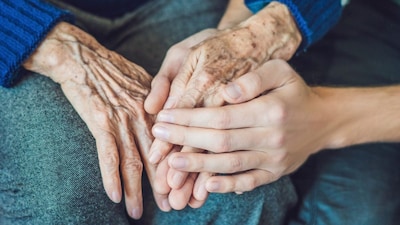Summarized by AI.

Share Your Feedback
India still likes to describe itself as a young nation – restless, ambitious, bursting with working-age energy. But quietly, almost imperceptibly, the country is growing old. In the next 25 years, this “youth capital” will start to grey at the temples. By 2050, nearly one in every five Indians will be above the age of 60.
That means over 320 million elderly people, almost double today’s count and a surge in the “oldest-old,” those above 80. It’s a demographic transition that will reshape how India works, heals, and lives, even as most of the country refuses to acknowledge it.
A slow shift, invisible in everyday life
The shift is not loud or dramatic. It unfolds in quiet corners of homes and hospitals, a widowed mother in Mysuru struggling with rising rent, a retired teacher in Lucknow skipping medicines to save her pension money, a son in Mumbai trying to juggle work calls while caring for a bedridden father.
Ageing in India doesn’t happen in nursing homes or assisted-living facilities. It happens in small apartments, in crowded lanes, behind closed doors where families carry the weight alone.
UNFPA and NITI Aayog data both project that by 2050, the elderly will make up around 20 percent of India’s total population. The fastest-growing segment will be women over 80 mostly widowed, financially dependent, and at risk of neglect.
In a country that’s still building schools for its children, the idea of building care systems for its elderly feels alien. Yet, this quiet ageing will define the next phase of India’s social story.
Longevity without safety
Longer life should mean better life, but for millions of older Indians, it simply means a longer struggle. The country’s life expectancy has improved dramatically in the past five decades, but quality of life has not kept pace.
Many elders live with multiple chronic illnesses – diabetes, arthritis, hypertension, often untreated or under-treated. Physical decline is compounded by loneliness and anxiety, especially in nuclear families and migrant households where adult children work far away.
A national study on ageing found that more than one-third of India’s elderly face difficulties performing daily tasks without assistance. For them, old age is not about leisure or reflection, but dependence.
As families shrink, this dependence translates into guilt, resentment, and, at times, abuse — emotional, financial, or physical. Yet these experiences remain largely unspoken, hidden under the cultural expectation that families will take care of their own.
The health system gap
India’s healthcare system was designed for another era, one that fought communicable diseases, maternal mortality, and malnutrition. It has not evolved for the slow, chronic conditions that accompany longer life.
The National Programme for Health Care of the Elderly exists on paper, but most primary health centres are not equipped to deal with dementia, fall injuries, or long-term palliative care. Hospitals still function on an acute-care model – diagnose, treat, discharge with little thought for continuous support.
In smaller towns, geriatric wards are rare. In rural areas, older patients often depend on untrained informal care or home remedies. Even in cities, the lack of trained caregivers, physiotherapists, and geriatric nurses means families shoulder the entire burden. The emotional cost is heavy. The financial cost is heavier still.
The pension paradox
India’s social safety nets have widened, but they are still shallow. The national old-age pension scheme offers as little as Rs 200 a month from the Centre for those aged 60 to 79.
States add their own top-ups, but even the highest combined pensions barely cover basic medication, let alone rent or nutrition. In a time of soaring healthcare costs and shrinking family incomes, these payments feel more symbolic than sustaining.
The irony is sharp: India’s GDP is growing faster than ever, but its elderly are growing poorer. Many of them, especially women, spent lifetimes in unpaid domestic work and have no contributory pension to fall back on. They live off savings, children, or sheer luck. As inflation erodes the little they have, poverty in old age becomes a quiet, undignified reality.
The feminisation of ageing
Women live longer but with fewer resources. By 2050, women will make up the majority of India’s elderly and an even larger share of the oldest-old. Many will outlive their spouses by years, sometimes decades, left to navigate old age alone.
A lifetime of unpaid caregiving leaves them without savings, property rights, or social power. Ageing for women is not just a biological process; it’s a continuation of inequality.
The emotional toll is harder to measure but easy to feel. Many widows in rural areas face social isolation, sometimes treated as burdens or symbols of bad luck. In cities, the modern loneliness looks different but feels the same – a life spent in the shadow of adult children’s schedules. The state offers little psychological or social support for this hidden epidemic of isolation.
The family myth
For decades, policymakers assumed that India didn’t need a strong elder-care system because “the family will take care of it.” That assumption no longer holds. Urbanisation, migration, and changing gender roles have broken the old caregiving structure.
The joint family, once India’s social insurance has given way to small nuclear units, often living far apart. Women, traditionally the unpaid caregivers, are now part of the workforce. Children study and settle abroad. The safety net has frayed beyond repair.
Today, most families caring for elderly members do so with no training, no respite, and no financial support. Burnout among middle-aged caregivers is becoming a silent crisis. Those who can afford help turn to private home-care agencies, often unregulated and inconsistent in quality. Those who cannot simply cope until they can’t anymore.
The cities aren’t ready either
India’s urban design is another silent enemy of its elderly. Broken footpaths, overcrowded buses, stair-only access, and the absence of public toilets make everyday movement risky. One fall can undo years of health.
Few Indian cities have adopted age-friendly planning like ramps, benches, tactile pavements, shaded crossings – the simple features that make independence possible. Public spaces are designed for the young, while the old learn to stay indoors.
Some progress, but too little, too late
To be fair, a few states have begun responding. Kerala and Tamil Nadu have introduced community-based programmes for senior citizens. Delhi has expanded its old-age pension coverage. A handful of hospitals now have geriatric clinics and memory wards.
NGOs and volunteer groups are stepping in where the state steps back. But these remain islands of progress in a sea of neglect. Without a coherent national strategy that links healthcare, pensions, housing, and urban design, ageing will stay a fragmented problem managed, not solved.
The economic cost of looking away
The consequences of inaction are not just moral but economic. As the working-age population stabilises and fertility rates drop, India’s growth story will increasingly depend on older citizens staying healthy and productive.
An ageing population without adequate care will strain public health spending, social welfare budgets, and families simultaneously. Analysts warn that India’s much-celebrated demographic dividend could invert into a demographic burden if the country fails to prepare for the long tail of longevity.
Planning for ageing isn’t just about compassion; it’s about economic prudence. Nations like Japan and South Korea have already discovered how expensive neglect can be — soaring healthcare bills, labour shortages, and caregiving crises that ripple across generations.
The choice ahead
India’s future depends on whether it chooses to grow up as it grows old. Ageing isn’t a tragedy; it’s the natural result of success – better health, longer lives, fewer deaths. But longevity without dignity is a hollow victory. What the elderly need is not charity but design: accessible hospitals, inflation-linked pensions, trained caregivers, and cities built for all ages.
The old-age crisis is not arriving someday in the future. It’s already here in every medicine skipped, in every widow waiting for her pension, in every son carrying his father up a flight of stairs. A young nation may dream of the future, but a wise one plans for it. If India wants to remain both, it must start now.
A slow shift, invisible in everyday life
The shift is not loud or dramatic. It unfolds in quiet corners of homes and hospitals, a widowed mother in Mysuru struggling with rising rent, a retired teacher in Lucknow skipping medicines to save her pension money, a son in Mumbai trying to juggle work calls while caring for a bedridden father.
Ageing in India doesn’t happen in nursing homes or assisted-living facilities. It happens in small apartments, in crowded lanes, behind closed doors where families carry the weight alone.
UNFPA and NITI Aayog data both project that by 2050, the elderly will make up around 20 percent of India’s total population. The fastest-growing segment will be women over 80 mostly widowed, financially dependent, and at risk of neglect.
In a country that’s still building schools for its children, the idea of building care systems for its elderly feels alien. Yet, this quiet ageing will define the next phase of India’s social story.
Longevity without safety
Longer life should mean better life, but for millions of older Indians, it simply means a longer struggle. The country’s life expectancy has improved dramatically in the past five decades, but quality of life has not kept pace.
Many elders live with multiple chronic illnesses – diabetes, arthritis, hypertension, often untreated or under-treated. Physical decline is compounded by loneliness and anxiety, especially in nuclear families and migrant households where adult children work far away.
A national study on ageing found that more than one-third of India’s elderly face difficulties performing daily tasks without assistance. For them, old age is not about leisure or reflection, but dependence.
As families shrink, this dependence translates into guilt, resentment, and, at times, abuse — emotional, financial, or physical. Yet these experiences remain largely unspoken, hidden under the cultural expectation that families will take care of their own.
The health system gap
India’s healthcare system was designed for another era, one that fought communicable diseases, maternal mortality, and malnutrition. It has not evolved for the slow, chronic conditions that accompany longer life.
The National Programme for Health Care of the Elderly exists on paper, but most primary health centres are not equipped to deal with dementia, fall injuries, or long-term palliative care. Hospitals still function on an acute-care model – diagnose, treat, discharge with little thought for continuous support.
In smaller towns, geriatric wards are rare. In rural areas, older patients often depend on untrained informal care or home remedies. Even in cities, the lack of trained caregivers, physiotherapists, and geriatric nurses means families shoulder the entire burden. The emotional cost is heavy. The financial cost is heavier still.
The pension paradox
India’s social safety nets have widened, but they are still shallow. The national old-age pension scheme offers as little as Rs 200 a month from the Centre for those aged 60 to 79.
States add their own top-ups, but even the highest combined pensions barely cover basic medication, let alone rent or nutrition. In a time of soaring healthcare costs and shrinking family incomes, these payments feel more symbolic than sustaining.
The irony is sharp: India’s GDP is growing faster than ever, but its elderly are growing poorer. Many of them, especially women, spent lifetimes in unpaid domestic work and have no contributory pension to fall back on. They live off savings, children, or sheer luck. As inflation erodes the little they have, poverty in old age becomes a quiet, undignified reality.
The feminisation of ageing
Women live longer but with fewer resources. By 2050, women will make up the majority of India’s elderly and an even larger share of the oldest-old. Many will outlive their spouses by years, sometimes decades, left to navigate old age alone.
A lifetime of unpaid caregiving leaves them without savings, property rights, or social power. Ageing for women is not just a biological process; it’s a continuation of inequality.
The emotional toll is harder to measure but easy to feel. Many widows in rural areas face social isolation, sometimes treated as burdens or symbols of bad luck. In cities, the modern loneliness looks different but feels the same – a life spent in the shadow of adult children’s schedules. The state offers little psychological or social support for this hidden epidemic of isolation.
The family myth
For decades, policymakers assumed that India didn’t need a strong elder-care system because “the family will take care of it.” That assumption no longer holds. Urbanisation, migration, and changing gender roles have broken the old caregiving structure.
The joint family, once India’s social insurance has given way to small nuclear units, often living far apart. Women, traditionally the unpaid caregivers, are now part of the workforce. Children study and settle abroad. The safety net has frayed beyond repair.
Today, most families caring for elderly members do so with no training, no respite, and no financial support. Burnout among middle-aged caregivers is becoming a silent crisis. Those who can afford help turn to private home-care agencies, often unregulated and inconsistent in quality. Those who cannot simply cope until they can’t anymore.
The cities aren’t ready either
India’s urban design is another silent enemy of its elderly. Broken footpaths, overcrowded buses, stair-only access, and the absence of public toilets make everyday movement risky. One fall can undo years of health.
Few Indian cities have adopted age-friendly planning like ramps, benches, tactile pavements, shaded crossings – the simple features that make independence possible. Public spaces are designed for the young, while the old learn to stay indoors.
Some progress, but too little, too late
To be fair, a few states have begun responding. Kerala and Tamil Nadu have introduced community-based programmes for senior citizens. Delhi has expanded its old-age pension coverage. A handful of hospitals now have geriatric clinics and memory wards.
NGOs and volunteer groups are stepping in where the state steps back. But these remain islands of progress in a sea of neglect. Without a coherent national strategy that links healthcare, pensions, housing, and urban design, ageing will stay a fragmented problem managed, not solved.
The economic cost of looking away
The consequences of inaction are not just moral but economic. As the working-age population stabilises and fertility rates drop, India’s growth story will increasingly depend on older citizens staying healthy and productive.
An ageing population without adequate care will strain public health spending, social welfare budgets, and families simultaneously. Analysts warn that India’s much-celebrated demographic dividend could invert into a demographic burden if the country fails to prepare for the long tail of longevity.
Planning for ageing isn’t just about compassion; it’s about economic prudence. Nations like Japan and South Korea have already discovered how expensive neglect can be — soaring healthcare bills, labour shortages, and caregiving crises that ripple across generations.
The choice ahead
India’s future depends on whether it chooses to grow up as it grows old. Ageing isn’t a tragedy; it’s the natural result of success – better health, longer lives, fewer deaths. But longevity without dignity is a hollow victory. What the elderly need is not charity but design: accessible hospitals, inflation-linked pensions, trained caregivers, and cities built for all ages.
The old-age crisis is not arriving someday in the future. It’s already here in every medicine skipped, in every widow waiting for her pension, in every son carrying his father up a flight of stairs. A young nation may dream of the future, but a wise one plans for it. If India wants to remain both, it must start now.
Enjoy uninterrupted reading? Unlock the full story, distraction-free
Scan the QR code to download the News18 app and enjoy a seamless news experience anytime, anywhere.

login






